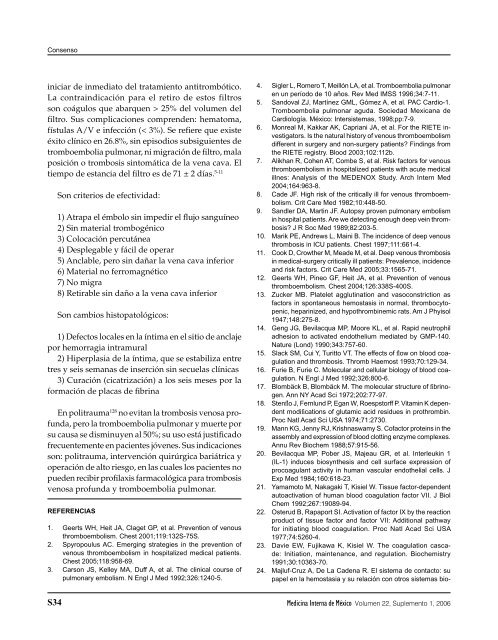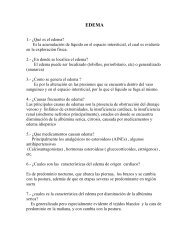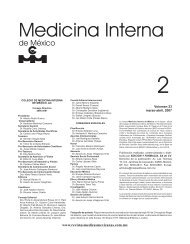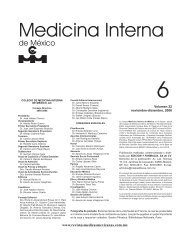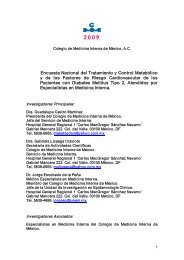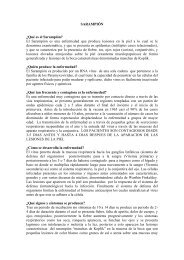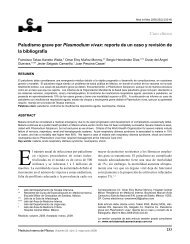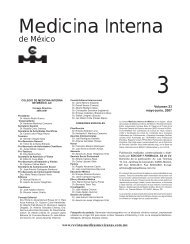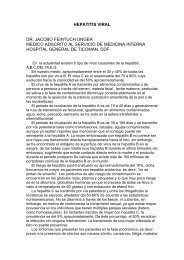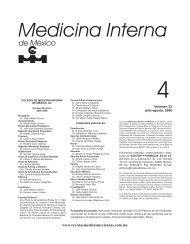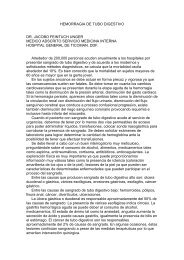Suplemento 1 - Colegio de Medicina Interna de México AC | CMIM
Suplemento 1 - Colegio de Medicina Interna de México AC | CMIM
Suplemento 1 - Colegio de Medicina Interna de México AC | CMIM
Create successful ePaper yourself
Turn your PDF publications into a flip-book with our unique Google optimized e-Paper software.
Consensoiniciar <strong>de</strong> inmediato <strong>de</strong>l tratamiento antitrombótico.La contraindicación para el retiro <strong>de</strong> estos filtrosson coágulos que abarquen > 25% <strong>de</strong>l volumen <strong>de</strong>lfiltro. Sus complicaciones compren<strong>de</strong>n: hematoma,fístulas A/V e infección (< 3%). Se refiere que existeéxito clínico en 26.8%, sin episodios subsiguientes <strong>de</strong>tromboembolia pulmonar, ni migración <strong>de</strong> filtro, malaposición o trombosis sintomática <strong>de</strong> la vena cava. Eltiempo <strong>de</strong> estancia <strong>de</strong>l filtro es <strong>de</strong> 71 ± 2 días. 5-11Son criterios <strong>de</strong> efectividad:1) Atrapa el émbolo sin impedir el flujo sanguíneo2) Sin material trombogénico3) Colocación percutánea4) Desplegable y fácil <strong>de</strong> operar5) Anclable, pero sin dañar la vena cava inferior6) Material no ferromagnético7) No migra8) Retirable sin daño a la vena cava inferiorSon cambios histopatológicos:1) Defectos locales en la íntima en el sitio <strong>de</strong> anclajepor hemorragia intramural2) Hiperplasia <strong>de</strong> la íntima, que se estabiliza entretres y seis semanas <strong>de</strong> inserción sin secuelas clínicas3) Curación (cicatrización) a los seis meses por laformación <strong>de</strong> placas <strong>de</strong> fibrinaEn politrauma 128 no evitan la trombosis venosa profunda,pero la tromboembolia pulmonar y muerte porsu causa se disminuyen al 50%; su uso está justificadofrecuentemente en pacientes jóvenes. Sus indicacionesson: politrauma, intervención quirúrgica bariátrica yoperación <strong>de</strong> alto riesgo, en las cuales los pacientes nopue<strong>de</strong>n recibir profilaxis farmacológica para trombosisvenosa profunda y tromboembolia pulmonar.REFERENCIAS1. Geerts WH, Heit JA, Claget GP, et al. Prevention of venousthromboembolism. Chest 2001;119:132S-75S.2. Spyropoulus <strong>AC</strong>. Emerging strategies in the prevention ofvenous thromboembolism in hospitalized medical patients.Chest 2005;118:958-69.3. Carson JS, Kelley MA, Duff A, et al. The clinical course ofpulmonary embolism. N Engl J Med 1992;326:1240-5.4. Sigler L, Romero T, Meillón LA, et al. Tromboembolia pulmonaren un período <strong>de</strong> 10 años. Rev Med IMSS 1996;34:7-11.5. Sandoval ZJ, Martínez GML, Gómez A, et al. P<strong>AC</strong> Cardio-1.Tromboembolia pulmonar aguda. Sociedad Mexicana <strong>de</strong>Cardiología. <strong>México</strong>: Intersistemas, 1998;pp:7-9.6. Monreal M, Kakkar AK, Capriani JA, et al. For the RIETE investigators.Is the natural history of venous thromboembolismdifferent in surgery and non-surgery patients? Findings fromthe RIETE registry. Blood 2003;102:112b.7. Alikhan R, Cohen AT, Combe S, et al. Risk factors for venousthromboembolism in hospitalized patients with acute medicalillnes: Analysis of the MEDENOX Study. Arch Intern Med2004;164:963-8.8. Ca<strong>de</strong> JF. High risk of the critically ill for venous thromboembolism.Crit Care Med 1982;10:448-50.9. Sandler DA, Martin JF. Autopsy proven pulmonary embolismin hospital patients. Are we <strong>de</strong>tecting enough <strong>de</strong>ep vein thrombosis?J R Soc Med 1989;82:203-5.10. Marik PE, Andrews L, Maini B. The inci<strong>de</strong>nce of <strong>de</strong>ep venousthrombosis in ICU patients. Chest 1997;111:661-4.11. Cook D, Crowther M, Mea<strong>de</strong> M, et al. Deep venous thrombosisin medical-surgery critically ill patients: Prevalence, inci<strong>de</strong>nceand risk factors. Crit Care Med 2005;33:1565-71.12. Geerts WH, Pineo GF, Heit JA, et al. Prevention of venousthromboembolism. Chest 2004;126:338S-400S.13. Zucker MB. Platelet agglutination and vasoconstriction asfactors in spontaneous hemostasis in normal, thrombocytopenic,heparinized, and hypothrombinemic rats. Am J Phyisol1947;148:275-8.14. Geng JG, Bevilacqua MP, Moore KL, et al. Rapid neutrophiladhesion to activated endothelium mediated by GMP-140.Nature (Lond) 1990;343:757-60.15. Slack SM, Cui Y, Turitto VT. The effects of fl ow on blood coagulationand thrombosis. Thromb Haemost 1993;70:129-34.16. Furie B, Furie C. Molecular and cellular biology of blood coagulation.N Engl J Med 1992;326:800-6.17. Blombäck B, Blombäck M. The molecular structure of fi brinogen.Ann NY Acad Sci 1972;202:77-97.18. Stenflo J, Fernlund P, Egan W, Roespstorff P. Vitamin K <strong>de</strong>pen<strong>de</strong>ntmodifi cations of glutamic acid residues in prothrombin.Proc Natl Acad Sci USA 1974;71:2730.19. Mann KG, Jenny RJ, Krishnaswamy S. Cofactor proteins in theassembly and expression of blood clotting enzyme complexes.Annu Rev Biochem 1988;57:915-56.20. Bevilacqua MP, Pober JS, Majeau GR, et al. Interleukin 1(IL-1) induces biosynthesis and cell surface expression ofprocoagulant activity in human vascular endothelial cells. JExp Med 1984;160:618-23.21. Yamamoto M, Nakagaki T, Kisiel W. Tissue factor-<strong>de</strong>pen<strong>de</strong>ntautoactivation of human blood coagulation factor VII. J BiolChem 1992;267:19089-94.22. Osterud B, Rapaport SI. Activation of factor IX by the reactionproduct of tissue factor and factor VII: Additional pathwayfor initiating blood coagulation. Proc Natl Acad Sci USA1977;74:5260-4.23. Davie EW, Fujikawa K, Kisiel W. The coagulation casca<strong>de</strong>:Initiation, maintenance, and regulation. Biochemistry1991;30:10363-70.24. Majluf-Cruz A, De La Ca<strong>de</strong>na R. El sistema <strong>de</strong> contacto: supapel en la hemostasia y su relación con otros sistemas bio-S34 <strong>Medicina</strong> <strong>Interna</strong> <strong>de</strong> <strong>México</strong> Volumen 22, <strong>Suplemento</strong> 1, 2006


